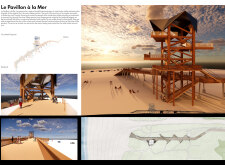5 key facts about this project
The pavilion functions as both a shelter and a public gathering space, strategically elevated to mitigate risks associated with flooding. This elevation is a key aspect of the design, allowing visitors to safely enjoy panoramic views while also providing an inviting environment for communal activities. The integration of mass timber throughout the structure embodies a thoughtful approach to sustainability while delivering aesthetic warmth and structural resilience. The use of engineered woods, such as cross-laminated timber and glued laminated timber, supports the project’s sustainability goals, reducing the carbon footprint typically associated with construction.
The layout of Le Pavillon à la Mer encourages movement and exploration, allowing people to navigate the space freely. The design incorporates a series of platforms and pathways that connect different levels, promoting accessibility for all users. This approach not only enhances the functionality of the pavilion but also fosters a sense of community. The thoughtful placement of seating areas encourages visitors to gather and interact, making the pavilion a social hub within the coastal environment.
Notable design details include extensive glass railings that provide unobstructed views while ensuring safety on the upper levels. This feature not only enhances the architectural quality of the project but also reinforces the connection between the indoor space and the natural surroundings. By integrating the structure into its landscape, the design respects and complements the local flora and fauna, creating a harmonious relationship with the environment.
The architectural philosophy driving Le Pavillon à la Mer reflects a commitment to resilience and community enhancement. The careful consideration of materials and design forms a cohesive whole that addresses both immediate safety concerns and long-term social connectivity. The pavilion stands as a testament to the possibilities of modern architectural design, showcasing how buildings can serve dual purposes without sacrificing aesthetic or functional qualities.
For those interested in exploring these architectural ideas further, examining the architectural plans, sections, and designs of Le Pavillon à la Mer can provide deeper insights into how such thoughtful design solutions are crafted. The interplay between environmental considerations and community needs presents a compelling case study for contemporary architecture in vulnerable coastal regions, inviting further discussion and exploration of its unique contributions to public architecture.























